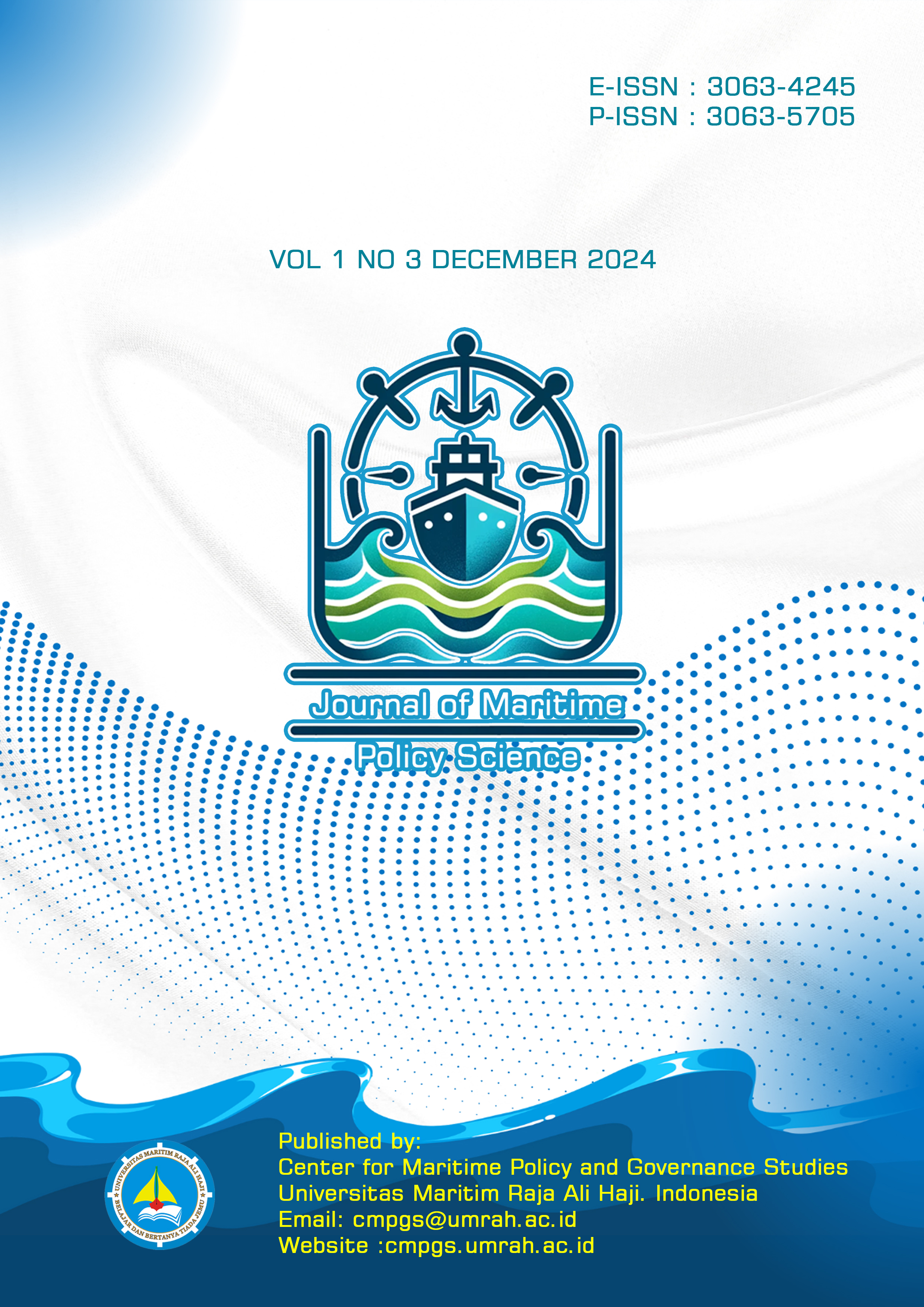Implementation of the Measured Fishing Policy-Penangkapan Ikan Terukur (PIT) in the Riau Islands Province
DOI:
https://doi.org/10.31629/jmps.v1i3.7406Keywords:
Measured Fishing Policy, Implementation, LogbookAbstract
The implementation of the Measured Fishing Policy/Penangkapan Ikan Terukur (PIT) in the Riau Islands Province is a strategic step to manage fishery resources sustainably. The background of this study focuses on the challenges faced in the implementation of the PIT policy, including filling in logbooks by 10-30 GT fishing vessels, conflicts between traditional fishermen and industry players, and limited supporting infrastructure. This study aims to analyze the implementation of the PIT policy using the Van Meter and Van Horn theory, which refers to four main indicators: communication, resources, bureaucratic structure, and implementer disposition. The research method used is a descriptive qualitative approach, with secondary data collection and triangulation analysis to increase validity and reliability. The results of the study indicate that the implementation of the PIT policy in the Riau Islands still faces obstacles in the form of uneven communication, lack of skilled human resources, and inadequate infrastructure. The complex bureaucratic structure also hinders the efficiency of policy implementation. However, government efforts, such as policy socialization through training and the establishment of the Fisheries Management Institution (LPP) in WPPNRI 711, have begun to show positive impacts. In conclusion, the successful implementation of the PIT policy requires a holistic approach that includes strengthening human resources, infrastructure investment, bureaucratic reform, and inclusive communication strategies. Thus, this policy is expected to contribute to the sustainability of marine ecosystems and the welfare of coastal communities in the Riau Islands Province
References
Ambari, M. (2023). Resmi, penangkapan ikan terukur dimulai. Mongabay.co.id. https://www.mongabay.co.id/2023/09/22/resmi-1-januari-2024-penangkapan-ikan-terukur-dimulai/
Cahyarani, A. (2024). Persepsi nelayan pemilik kapal Bouke Ami dan jala jatuh berkapal terhadap implementasi kebijakan perikanan terukur di PPS Nizam Zachman Jakarta. Jurnal Tidak Teridentifikasi.
Cahyarani, A., Susanto, A., & Hamzah, A. (2023). Perceptions of fishing vessel owners based at Ocean Fishing Port of Nizam Zachman Jakarta regarding the implementation of measurable fisheries policies. Agrikan Jurnal Agribisnis Perikanan, 16(2), 106–111. https://doi.org/10.52046/AGRIKAN.V16I2.1748
Gerungan, K. K. I., Darmastuti, R., & Kristiyani, D. N. (2024). Strategi komunikasi Kementerian Kelautan dan Perikanan dalam mensosialisasikan kebijakan penangkapan ikan terukur: Studi kasus nelayan Kota Tegal. Scriptura, 14(1), 1–13. https://doi.org/10.9744/SCRIPTURA.14.1.1-13
Jentoft, S. (2000). The community: A missing link in fisheries management. Marine Policy, 24(1), 53–60. https://doi.org/10.1016/S0308-597X(99)00009-3
Johnston, M. P. (2014). Secondary data analysis: A method of which the time has come. Qualitative and Quantitative Methods in Libraries, 3(3), 619–626. http://www.qqml-journal.net/index.php/qqml/article/view/169
Luthfia, S. S. (2023). Mengupas tata kelola perikanan nasional melalui PP No. 11 tahun 2023 tentang penangkapan ikan terukur demi mewujudkan blue economy. Jurnal RechtsVinding, 12(3), 483–502. https://jdih.maritim.go.id/cfind/source/files/jurnal/jurnal-hukum-mengupas-tata-kelola-perikanan-nasional-melalui-pp-no.-11-tahun-2023-tentang-penangkapan-ikan-terukur-demi-mewujudkan-blue-economy.pdf
Meter, D. S. Van, & Horn, C. E. Van. (1975). The policy implementation process: A conceptual framework. Administration & Society, 6(4), 445.
Moleong, L. J. (2012). Metodologi penelitian kualitatif. Remaja Rosdakarya.
Ngabalin, A. M. (2024). Application of measured fishing method in Kei Islands, Maluku Province. Jurnal Ilmiah Manajemen Kesatuan, 12(5), 1491–1498. https://doi.org/10.37641/JIMKES.V12I5.2793
Nurlaela, E. (2023). Penangkapan ikan terukur: Tantangan dan penerapan. Penerbit BRIN. https://doi.org/10.55981/brin.908.c759
Olsen, W. (2004). Methodological triangulation and realist research. In Making realism work: Realist social theory and empirical research (p. 197). Routledge.
Pelajar, K. P. M. (2023). Policy brief rencana kebijakan penangkapan ikan terukur (PIT). KPPMPI. https://knti.or.id/wp-content/uploads/2023/11/Policy_Brief__Rencana__Kebijakan_Penangkapan_Ikan_Terukur1-1.pdf
Pratiwi, A. M., & Boangmanalu, A. G. (2017). The existence and power of fisherwomen in Morodemak and Purworejo villages: Against violence, bureaucracy & biased religious interpretation. Jurnal Perempuan, 22(4), 295–305. https://garuda.kemdikbud.go.id/documents/detail/2392877
Rio, A. (2021). Membangun industri perikanan tanpa meminggirkan nelayan. Pemerintah Provinsi Kepulauan Riau. https://kepriprov.go.id/berita/pemprov-kepri/membangun-industri-perikanan-tanpa-meminggirkan-nelayan
Thurmond, V. A. (2001). The point of triangulation. Journal of Nursing Scholarship, 33(3), 253–258. https://doi.org/10.1111/J.1547-5069.2001.00253.X
Zaini, M. (2021). Kebijakan penangkapan ikan terukur dalam pengelolaan perikanan tangkap. Direktur Jenderal Perikanan Tangkap. https://www.icctf.or.id/wp-content/uploads/2021/09/Kebijakan-Penangkapan-Terukur-Paparan-Dirjen-Perikanan-Tangkap-KKP.pdf
Published
How to Cite
Issue
Section
License
Copyright (c) 2025 Dicky Novalino, Niken Wulandari

This work is licensed under a Creative Commons Attribution-ShareAlike 4.0 International License.
Journal of Maritim Policy Science This work is licensed under
a Creative Commons Attribution-ShareAlike 4.0 International License
You are free to:
- Share — copy and redistribute the material in any medium or format for any purpose, even commercially.
- Adapt — remix, transform, and build upon the material for any purpose, even commercially.
- The licensor cannot revoke these freedoms as long as you follow the license terms.
Under the following terms:
- Attribution — You must give appropriate credit, provide a link to the license, and indicate if changes were made . You may do so in any reasonable manner, but not in any way that suggests the licensor endorses you or your use.
- ShareAlike — If you remix, transform, or build upon the material, you must distribute your contributions under the same license as the original.
- No additional restrictions — You may not apply legal terms or technological measures that legally restrict others from doing anything the license permits.










